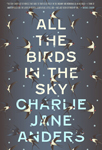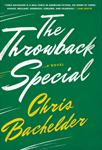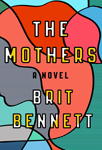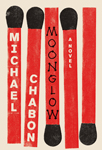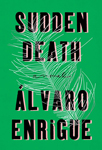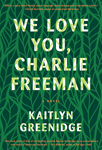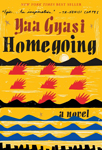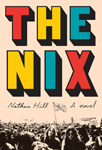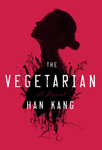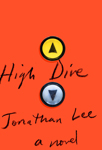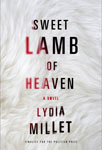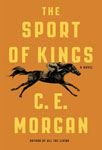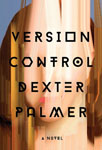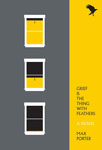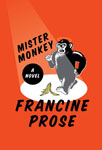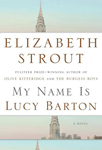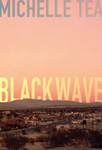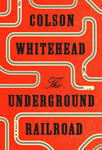by Charlie Jane Anders
Buy it at Powell’s »Lili Loofbourow: Reading these novels was like eating two courses of squid in its ink: You just don’t expect to experience a pleasure quite so specific twice, especially not back to back.
I don’t want to overstate the parallels between We Love You, Charlie Freeman and The Nix—these are wildly different stories. But the echoes here are real: Both novels concern painfully philosophical modes of maternal abandonment. Both concretely render the exhaustion of not belonging. Both muddle and bend American history through the points of view of multiple characters, hop between time periods, and splash historical wrongs into the present through a complex and itchy tesseract of a plot. Neither is remotely sentimental. Both revolve, surprisingly enough, around a woman symbolically overinvesting in an animal, be it a mythical horse or a real chimpanzee.
No novel is easy to describe, and these are harder than most. Take The Nix: It athletically pings and pongs between 1968, 1988, and 2011. It uses the story of a disaffected English professor named Samuel Andresen-Anderson—whose addiction to a videogame called World of Elfscape numbs the pain of being abandoned as a boy by his mother—to tell a 50-year story about America that connects Home Ec classes to Martin Luther King, Jr.’s assassination, the 1968 Chicago riots, and everything in between: bomb shelters, Norwegian myths, napalm manufacturing, police brutality, pedophilia, sociopathic millennials, Scotch tape, videogame history and addiction, gated neighborhoods, the Iraq war, Occupy Wall Street, plagiarism, ghostwriters, ghosts, John Cage, and the metastatic brilliance of aging agent provocateurs.
The novel’s conceptual scaffolding is Samuel’s mother Faye’s belief in a story her father told her about the nisse, a friendly white horse that would invite children to mount it only to lead them through fear to luck, possession, pride, terror, and finally death. These days, Faye says, it takes human shape: “anyone you fall in love with before you’re an adult is probably a Nix.” She believes she is her son Samuel’s Nix, and that—to make a very complex story simple—is why she abandons him.
We Love You, Charlie Freeman leapfrogs between 1929, 1990, and—in the epilogue—2011. A black family moves into the thickly carpeted, rich but sinister Toneybee Institute to cohabit with a chimpanzee named Charlie in the name of science, and the novel crawls into the gothic shadows of exactly what American “science” has meant since the Institute’s founding. (Among other things: eugenics, racism, and using “objectivity” as a pretext to exploit.) Complemented by sections from “Nymphadora”, a 36-year-old teacher seduced in 1929 into posing for one of the Institute’s scientists, the novel spirals out into other histories and perspectives to illuminate why the Freemans ended up here in 1990. Basically, Laurel Freeman, the mom, thought Charlie could give meaning to her formative loneliness through science. But Charlotte, her oldest daughter, starts suspecting that rather than partnering with scientists studying Charlie the chimp, the Freemans are actually experimental subjects with him.
For Charlotte, in whose head we spend the most time, the tragedy is how little her mother Laurel minds their status as specimens. Laurel’s bond is with Charlie the chimp, her scientific commitments those of a zealot. The ambient racism, the man videotaping them, the loss of privacy all leave her unfazed: “It doesn’t matter why they think we’re here,” she tells Charlotte. “What matters is we’re here.” Laurel—a woman so fascinating I wanted more chapters with her—believes in the work. So, in a very different way, does Callie, the youngest Freeman. Charlie is, you might say, their Nix.
Charlie Freeman beautifully marries real to fake history. Kaitlyn Greenidge’s sociology of the Stars of the Morning (a group to which Nymphadora belonged) was so riveting I was crushed to learn they never existed. There are clever fake texts like Dr. Frances Gray’s Man or Beast? and a letter from the Institute’s founder titled “What She Said to Me: An Apology to the African American People.” (Again, I thought this last was a historical document. It isn’t.) This book wears its satire lightly; that letter is perfect.
So are its epiphanies, which are economical and earned. Greenidge resists conclusions mightily—so much of this novel stages the paranoid ambiguity of wondering if race is in play—but there are a few big ones. Charlotte’s discovery of Dr. Gardner’s nude sketches, for instance, is achingly matter-of-fact: “I stared at them for a long time until I knew. I recognized the slope of a back and the insides of legs. And then I felt sick.” It parallels Nymphadora’s: “I thought at first that the curve I saw was mine, but then I looked at the head attached and saw, grinning back at me, the shivering smile of a chimpanzee.”
Where the novel wobbled for me was in sometimes failing to fully distinguish one character’s way of thinking from another. Everyone in the novel seems to notice and think in smells: “The scent of him stayed on my fingers, old and sharp, like a bottle of witch hazel,” Charlotte says. “The visitors had a queer scent, too, like a damp swath of canvas that had dried in grass,” Laurel thinks. “I smelled their death and then I read the letter,” Nymphadora writes. “Charlotte didn’t smell like home anymore,” Callie says. This could be part of the pattern or “tessellation” that Laurel’s father Charles describes toward the end—this is a novel built on echoes—but the characters sometimes feel like the products of a single gifted mind rather than fully distinct psychologies.
The other difficulty of a novel this ambitious is getting all those storylines and perspectives to pay off. As much as I appreciated the progression of “Nymphadora of Spring City” to “Nymphadora of Courtland County” and the echoes between Callie and Nymphadora, the end left me unsatisfied.
That’s where The Nix shines. At over 600 pages, Nathan Hill’s novel is a baroque Leviathan of interlocking parts (10 of them, each with several chapters). It sometimes feels indulgent, but in retrospect—given the ending—most of them are more than essential. Alternately comic, lyrical, manic, and subdued, the novel renders various states of mind and forms of thinking in stunning particularity—a partial list includes Hubert Humphrey, a senile Norwegian, a soldier, Walter Cronkite, and a confused high school girl who wants to go to college in 1968. Even when it’s less successful (as psychological portraits go, I found Laura Pottsdam and Charles Brown unconvincing), the novel introduces wacky experimental formats that feel organic: Samuel’s fight with his student is narrated through 16 different logical fallacies and bizarrely, it works. So does the Choose Your Own Adventure story, which only lets you turn to the next page.
Now, the risk with a novel this huge is that the author just stuffed in every trenchant observation he’s ever made. The Nix isn’t innocent of that. We didn’t need the prolonged description of Pwnage’s struggles to behave normally with a cashier, for example. Still, it does portray a peculiarly American affliction, and that is, to some extent, what The Nix sets out to do.
Where does that leave us? Both novels have ugly histories and great prose—and titular animals that collapse the distance between freedom and failure without dwelling much on their own symbolism. These books move. Literary Rube Goldberg machines, they stack causes and effects through perspectives that accrete to reveal an awful mechanical hole, a plot or conspiracy whose horror is precisely that it turned out not to have you at its center: Samuel’s writing career was a side effect. Nymphadora’s seduction barely featured her at all.
That’s a big mess to mop up. It means reconciling the huge payoff of a complicated plot with the shock of not mattering. Both novels do this well, but one does it better: The Nix wins by a nose.
Match Commentary
By Sue Kowalski & Jenny Fischer
Jenny Fischer: We are a couple of booksellers from Glen Ellyn, Ill., a western suburb of Chicago. Our 1,200-square-foot store, improbably named The Bookstore, has been on Main Street since 1960. We are passionate about books and reading, but not exactly renowned as writers. So this whole exercise has us a little nervous. But we love the Tournament of Books, so we were thrilled to be invited to provide this commentary.
Sue Kowalski: We’re passionate readers all right, but I’m such a non-writer that I need to be forced to fill out the staff pick cards that we put in all of our favorite books. I was a math major in college and did that just to avoid any more book reports.
Jenny: And before becoming a bookseller 19 years ago I taught second grade—no need for big words.
Sue: This reminds me of what I love about the ToB: When I finish a book, I have a terrible time articulating what I liked or didn’t like about it. I rely on my favorite book critics as well as some of these judges to help me explain my feelings. With that being said, let’s talk about this judgment!
Jenny: I hoped against hope that The Nix would be the winner. It was smart, funny, and timely. Sometimes when authors try to fit 40 topics into one book it just annoys me, but not in this case. I loved the back and forth in time and subject. I laughed out loud so many times that a group of girlfriends I was vacationing with wanted me to read a funny selection aloud. I chose the scene where Laura ends up with the chunk of brontosaurus burger in her mouth. I thought it was hilarious. They didn’t ask for any more.
Sue: Oh, I wonder why. I also laughed out loud and at the same time felt the pain of many of the characters. There were so many abandonments and losses of children, parents, and friends. These themes really paralleled We Love You, Charlie Freeman.
Jenny: You and I are both suckers for heartbreaking family stories. There were pages I felt Nathan Hill was writing as I read. How could a book that was started in 2006 be so spot-on for 2017? From an abhorrent politician to protesters to social media that consumes our time and news, this book has it all. At the very end, Samuel and his editor, Periwinkle, talk about “alternative facts”:
What’s true? What’s false? In case you haven’t noticed, the world has pretty much given up on the old Enlightenment idea of piecing together the truth based on observed data. Reality is too complicated and scary for that. Instead, it’s way easier to ignore all the data that doesn’t fit your preconceptions and believe all data that does. … It’s liberal tolerance meets dark ages denialism. It’s very hip right now.
Sue: That quote is almost too perfect for these days of Sean Spicer trying to justify what’s coming out of the White House. Don’t get me started on his boss. I’m with you in that I wholeheartedly agree with this decision, but we have been remarking that We Love You, Charlie Freeman is stuck in our heads.
Jenny: And I don’t want him stuck there. He creeped me out as he wedged his way into the Freeman family, taking away the sisters’ stability and home. Although it wasn’t the chimp’s fault; Laurel and Charles let it happen. I needed to look up why the doctor constantly chewed on chalk—“It was the yellowiest, craggiest, driest tongue I’d ever seen.” Yuck! I know this is an important and powerful story of race and history. But I saw it more as a family story.
Sue: This brings up another point about the timeliness of these novels. We Love You, Charlie Freeman has a lot to do with how we deal with history; Charlotte’s friend even states, “History is a weapon.” And it should be. So how do two lily-white booksellers internalize the serious messages that Kaitlyn Greenidge conveys and really understand them?
Jenny: We just came home from Winter Institute in Minneapolis, a four-day educational event for independent booksellers from around the world. The keynote speaker was Roxane Gay (a previous ToB contender and judge!) Anyone who has heard her knows she is a powerhouse when it comes to talking about race and diversity. And her point was that we need to stop talking and start doing. She said, “For the foreseeable future, everything we do is political as readers, as writers, as booksellers, as people.” Funny how we both “voted” for The Nix but can’t stop talking about We Love You, Charlie Freeman.
Sue: But I really did love The Nix. Judge Loofbourow writes about how ambitious both of these novels are with respect to having all of the storylines and perspectives pay off, and I echo her statement, “That’s where The Nix shines.” I appreciated every thread of that story, particularly the historical perspectives, in part because I’m old enough to remember the bomb shelters, the 1968 Chicago riots, video game history (I’ve had them all since the beginning of video game time). Oh no—I’ve just let on that I’m not a young hip bookseller!
On the other hand, the Nymphadora story in We Love You, Charlie Freeman just left me cold. When I think about how much I want to discuss that book (and we are doing a lot of that), I’m leaving out Nymphadora.
Jenny: As we’ve hashed this out, it’s evident that both books have made a lasting impression. Periwinkle says, “In today’s market, most readers want books with accessible, linear narratives that rely on big concepts and easy life lessons.” Not true! It’s all the confusing, complicated, and disconnected parts that challenge us.
Sue: WAIT! (Who’s that detective that keeps coming back with one more thing?) I don’t feel I’ve given Judge Loofbourow enough praise for her well-written decision. It’s one thing to say we agree with it, but I was so impressed with how she could pull together all those ideas, summarizing plots, themes, you name it into one judgment. It’s what I love about this tournament!
Kevin Guilfoile: Multitudes of gratitude to Sue and Jenny for stepping up today. Terrific job. The Bookstore has been a longtime booster of the ToB, and Sue was directly responsible for the inclusion of Evie Wyld’s All the Birds, Singing on the 2015 shortlist. That was a book I hadn’t even been aware of and it became one of my favorite novels of that year. On Monday the opening round wraps up as Mister Monkey by Francine Prose takes on the winner of our pre-tourney play-in match, Sudden Death by Álvaro Enrigue. Pamela Ribon will be doing the judging. She was one of the screenwriters of Moana, y’all! I tell you what, I dreaded taking my kids to that movie, but I loved it. Borrow a kid and go see it.
John Warner: Jeff Martin, the founder of Magic City Books, will be doing the red blazer work along with the boss Rooster, Rosecrans Baldwin of The Morning News, but Kevin and I will return briefly to make our first Zombie announcement of the tourney.
Kevin: But before the excitement of next week, Drew Broussard and Christopher Hermelin from the podcast So Many Damn Books will return tomorrow to break down the week’s events on another Facebook Live broadcast at our page. There’s a lot to talk about, and it all starts at noon Eastern. See you then.



